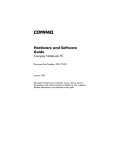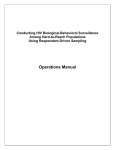Download User's Guide - Tablelands Regional Council
Transcript
User’s Guide to the Planning Scheme EACHAM SHIRE COUNCIL November 2006 2006 User’s Guide to the Eacham Planning Scheme CONTENTS 1.0 INTRODUCTION ............................................................................... 1 1.1 Relationship between the Planning Scheme and the Integrated Planning Act 1997.............................................................................. 2 2.0 STRUCTURE OF THE PLANNING SCHEME .................................. 3 2.1 2.2 2.3 2.4 2.5 Part 1 – Administration & Assessment Requirements....................... 3 Part 2 – Desired Environmental Outcomes ....................................... 3 Part 3 – Assessment Requirements .................................................. 4 Part 4 – Planning Scheme Codes...................................................... 4 Planning Scheme Policies ................................................................. 5 3.0 GUIDE TO THE DEVELOPMENT APPLICATION PROCESS......... 6 3.1 3.2 3.3 3.4 IPA & IDAS – The Basics................................................................... 6 Determining if a Development Application is required....................... 6 The IDAS Process ............................................................................. 8 Application Stage ............................................................................... 8 Determining the Level of Assessment...................................................8 Making an Application ...........................................................................9 Lodging the Application.......................................................................11 Where to lodge an application.............................................................11 Council's Acknowledgment Notice ......................................................12 3.5 Information and Referral Stage........................................................ 12 Referral to Referral Agencies ..............................................................12 Referral Coordination ..........................................................................12 Information Request............................................................................13 Responding to an Information Request...............................................13 3.6 Notification Stage............................................................................. 13 Purpose of Public Notification .............................................................13 When can Public Notification Commence? .........................................14 What is required for Public Notification? .............................................14 Commenting on an Application ...........................................................15 3.7 Decision Period................................................................................ 16 Assessing an Application ....................................................................16 Deciding the Application......................................................................17 Decision Notice ...................................................................................18 3.8 What happens after Council's decision?.......................................... 19 When an approval takes effect............................................................19 How long does an approval last? ........................................................19 When an approval lapses....................................................................20 Making minor amendments to approvals ............................................20 Request to change or cancel conditions .............................................20 4.0 GLOSSARY ..................................................................................... 21 5.0 PUBLIC NOTIFICATION SIGN/ADVERTISEMENT ....................... 23 6.0 NOTICE TO ADJOINING OWNERS ............................................... 24 7.0 NOTICE OF COMPLIANCE ............................................................ 25 1.0 INTRODUCTION This User’s Guide has been prepared to assist in the interpretation and implementation of the new Planning Scheme for Eacham Shire (which th came into effect on the 14 November 2006) and implement the Integrated Development Assessment System (IDAS). The Planning Scheme replaces the previous Planning Scheme for Eacham Shire (which was in force from 1989 to 2006). The Eacham Shire Planning Scheme has been prepared in accordance with the provisions of the Integrated Planning Act 1997 (IPA) and reflects the current views and interests of the local residents and the desire of the Eacham Shire Council to provide an appropriate environment for existing and future residents and visitors. The Planning Scheme also integrates State and regional aspects of the matters dealt with in the Scheme. The scheme applies to the whole of Eacham Shire and – identifies the broad outcomes sought for Eacham Shire as well as more detailed outcomes in relation to certain matters or parts of the Shire; allocates land for different uses having regard to a range of considerations; identifies areas or places that constrain the use of land due to their environmental value or their adverse effects on development; identifies the kind of development that requires approval (assessable development) as well as activities that can be carried out without approval if certain requirements are met (selfassessable development); and specifies detailed criteria (codes) to be used together with the detailed outcomes for assessing the suitability of a development proposal. The Planning Scheme manages development by using zones, overlays, assessment tables and codes. The Planning Scheme is outcome based. The outcomes in the Scheme are expressions of the intended end-state of a development or area. The Planning Scheme outcomes do not present actions that the Council is going to undertake in a public works program. How does the new Planning Scheme differ from the previous Planning Scheme? The new Planning Scheme is a performance based plan. The structure of the Planning Scheme is also different. Some of the key differences and similarities between the previous Planning Scheme and the new Planning Scheme include – Land Use Definitions are generally similar; The Strategic Plan is replaced with Desired Environmental Outcomes; Zones are generally the same with the addition of an Urban Expansion Zone; All development provisions are contained within the Codes; Codes relate to specific uses/activities; and Subdivision Requirements are also contained in the Scheme. “The Planning Scheme sets out Council’s planning and development intentions and applies to the whole of Eacham Shire” User’s Guide to the Eacham Planning Scheme 1.1 Relationship between the Planning Scheme and the Integrated Planning Act 1997 The Planning Scheme is the way the Eacham Shire Council identifies the circumstances when development must meet certain criteria (selfassessable) or a development application is required (assessable). Through Schedule 8 of the Integrated Planning Act 1997 (IPA), the State government identifies self-assessable and assessable development. For example, Schedule 8 makes building work (assessable against the Standard Building Regulation (SBR)), Environmentally Relevant Activities and licensed brothels assessable development. Unlike the Eacham Shire Planning Scheme which applies only in the Shire, Schedule 8 applies consistently across the State. The Planning Scheme and Schedule 8 complement each other. However, if there is any inconsistency between them, Schedule 8 prevails. A proposal may be assessable under both the Planning Scheme and Schedule 8 of IPA “The purpose of IPA is to seek to achieve ecological sustainability.” A proposal may involve development identified as requiring a development application by both the Planning Scheme (e.g. to establish a new shop) and by schedule 8 (e.g. for erecting the building). In most instances the application is made to the Eacham Shire Council who is then responsible for assessing both aspects of the proposal. However in other instances the assessment arising from schedule 8 may be required to be undertaken by a State government department. In this instance the application is made to the Eacham Shire Council and the State government department becomes involved as a referral agency. Alternatively, the applicant may choose (if possible) to make separate applications (i.e. one for the Planning Scheme assessment and one for the schedule 8 assessment). If the application is triggered by schedule 8 only, the assessment manager for the application may be either the Eacham Shire Council or, as is more often the case, a State government department such as the Environmental Protection Agency (EPA) or Department of Natural Resources & Water (NRW). If an application is required, it will be assessed and decided using the Integrated Development Assessment System (IDAS). This is the case regardless of whether the application is required by the Planning Scheme or schedule 8, and regardless of whether the assessment manager is the Eacham Shire Council, a State government department, or a private building certifier. For further details about determining if a development application is required, refer to Section 3.0 of this Guide. 2.0 STRUCTURE OF THE PLANNING SCHEME The Planning Scheme manages development by using features such as Desired Environmental Outcomes, zones, overlays, development assessment tables and codes. PART 1 Administration & Asssessment Requirements The Planning Scheme consists of four parts, being – PART 1 PART 2 PART 3 PART 4 Administration & Assessment Requirements Desired Environmental Outcomes Assessment Requirements Planning Scheme Codes Schedules are contained at the end of the Scheme, to provide guidance on matters contained in the Planning Scheme Codes. 2.1 PART 3 Asssessment Requirements Part 1 – Administration & Assessment Requirements Part 1 of the Planning Scheme contains the administrative components of the Planning Scheme including – administration; an explanation of the terms used throughout the Planning Scheme (administrative definitions); and use definitions. Using the Definitions to Determine a Land Use The Use definitions have a specific meaning for the purpose of the Assessment Tables in the Planning Scheme. The definitions should be used to determine a land use for a proposed ‘development. The Uses are grouped in seven (7) categories – Residential; Business and Retail; Trades and Industry; Rural; Tourism; Community Infrastructure and Facilities; and Other Development Activities. 2.2 PART 2 Desired Environmental Outcomes Part 2 – Desired Environmental Outcomes Part 2 outlines the broad outcomes and development intent for the Shire by specifying Shire wide Desired Environmental Outcomes (DEOs) which is supported by a Plan (Planning Scheme Map - Strategic Framework Map) that depicts the preferred land use pattern for the Shire. Desired Environmental Outcomes The Desired Environmental Outcomes (DEOs) set a broad policy for the Shire and describe the desired intent or outcomes for the area and express what is sought to be achieved by the Planning Scheme. The DEOs apply to the whole of the Shire and cover a broad range of issues such as the land use pattern, environment, economic development, infrastructure needs and cultural heritage. PART 4 Planning Scheme Codes PLANNING SCHEME POLICIES & SCHEDULES User’s Guide to the Eacham Planning Scheme 2.3 Part 3 – Assessment Requirements Within the Shire, all land is included in a Zone. The zone of a particular parcel of land is identified on maps accompanying the Planning Scheme. There are 11 Planning zones, as follows – Rural Zone Rural Residential Zone Urban Expansion Zone Residential Zone Village Zone Business and Retail Zone Trades and Services Zone Industry Zone Open Space Zone Conservation Zone Public Purposes Zone In addition to zones, the Planning Scheme uses overlays as a separate layer to identify areas or places that constrain the use of land due to their environmental value or their adverse effects on development e.g. cultural heritage features, steep slopes. An overlay is a separate layer that applies across zones and is identified on maps or in lists accompanying the Planning Scheme. The tables of assessment for each Planning Zone specify the applicable level of assessment, as well as specifying the applicable Codes to guide assessment. There is also an assessment table for other aspects of development (e.g. advertising signs and operational work) which applies to all zones. It should be noted that the level of assessment for development may vary depending upon the locality and whether or not an overlay applies. 2.4 Part 4 – Planning Scheme Codes The Planning Scheme contains criteria against which development is assessed. These criteria may be contained in codes. Codes may relate to a zone, overlay or specific purpose or type of development. Part 4 includes the Codes applicable to self-assessable and assessable development which are identified in the Tables of Assessment in Part 3. Codes The codes included in the Planning Scheme are – Zone Codes; Land Use Codes; General Development Codes; and Overlay Codes. Assessment criteria in codes consists of – applicability; purpose of the code; and development principles. The format of the codes may differ based on whether it is applicable to self-assessable or code assessable development. A code for selfassessable development contains a list of precise requirements (acceptable solutions) so that it is easy for the person undertaking the development to recognise whether the proposal satisfies the requirements. A code for code assessable development contains a clearly stated purpose (Purpose) that is supported by intended outcomes (Performance Criteria) and sometimes design solutions for achieving the intended outcomes (Acceptable Solutions). The intended outcomes may relate to all development to which the code relates, or may be specific to a type of development activity, certain uses, the location of the proposal, etc., in which case only the outcomes relevant to the proposal are applicable. An acceptable solution nominates one way for achieving all or part of the applicable intended outcome. The applicant may demonstrate achievement of the intended outcomes in another way and the Eacham Shire Council may vary the specific criteria in an approval. 2.5 Planning Scheme Policies The Planning Scheme Policies provide supporting information and guidance to assist in the submission of development proposals and material to support the Codes contained in the Planning Scheme. The Planning Scheme Policies should be reviewed for applicability to a proposed development. Each Policy outlines when it is applicable to development. User’s Guide to the Eacham Planning Scheme 3.0 GUIDE TO THE DEVELOPMENT APPLICATION PROCESS 3.1 IPA & IDAS – The Basics The Integrated Planning Act 1997 (IPA) forms the foundation of Queensland’s planning and development assessment legislation. IDAS stands for Integrated Development Assessment System and is the stepby-step process for making, assessing and deciding development applications under the Integrated Planning Act 1997. 3.2 Determining if a Development Application is required To work out whether an application is needed for your project proposal, consider the following two questions: Does the project involve 'Development' under the Act? The term 'Development' includes the following actions – carrying out building work; carrying out drainage or plumbing work; carrying out operational work; reconfiguring a lot – including subdivision, rearranging lot boundaries, subdivision by lease (exceeding 10 years), creating an access easement; and/or making a material change of use – including starting a new use, a change to the intensity of a use, and re-establishing an abandoned use. To determine whether your proposal constitutes a form of development, refer to the Glossary of terms used in this Application Guide. A proposal will generally involve at least 2 of the above development activities. For example – The erection of a new office or shop involves – material change of use for the start of the new use on the premises building work to erect the new building plumbing and drainage works for water and sewerage fixtures and operational work if a new vehicle cross-over or open-air car parking area is proposed. Subdividing land for new houses involves – material change of use for the change or intensification of the use of the land reconfiguring a lot to subdivide the land operational work if the subdivision involves a new road or the provision of new services such as water and sewerage reticulation. “IDAS is the step-by-step process for making, assessing and deciding development applications” Is the Development Assessable? Not all development activities associated with a proposal require an application to be made. There are three assessment categories for 'Development' under the Integrated Planning Act (IPA). Exempt - No IDAS application is required and the proposal is not required to comply with any codes or standards. For example, weed and pest control, or earthwork for the purpose of farm management practices. Self-Assessable - No IDAS application is required. Development in this category is however, required to comply with applicable codes such as Council's Planning Scheme provisions or State codes. For example, house extensions must comply with the Australian Building Code and Council's set back requirements. The provisions relating to Self-Assessable development are only identified in the Planning Scheme. Assessable (Code or Impact) - An IDAS Development Application is required prior to undertaking any new use or works. Assessable developments will require either Code or Impact assessment. The level of assessment for particular developments is determined by Part 3 of Council's Planning Scheme (refer to Section 2.3.1 1 above) and Schedule 8 of the IPA . Code Assessable If a development activity requires code assessment, that activity is assessed by The assessment manager against the applicable codes and The common material. Impact Assessment If a development activity requires impact assessment, the application is publicly notified and a broader assessment of the activity is carried out against all relevant Planning Scheme provisions. An application is only required if at least one of the development activities is categorised as assessable. However, a single application may involve both code and impact assessment. This will occur when an application involves two or more assessable development activities and one of the activities is identified as code assessable under either the Planning Scheme or Schedule 8 and another is identified as impact. 1 If inconsistency occurs between Council' s Tables of Development and Schedule 8 of the IPA, Schedule 8 of the IPA prevails. User’s Guide to the Eacham Planning Scheme 3.3 The IDAS Process Should a Development Application be required, the IDAS process must be followed. There are four (4) stages in the IDAS process – Application Stage; Information and Referral Stage; Notification Stage; and Decision Stage. However, not every application goes through all four stages. For example, an application for Building Works will usually only go through Stages 1 and 4, while an application requiring Impact Assessment (refer to Section 2.3.1) will need to go through all four stages. The following outlines the stages of IDAS applicable to each type of Development Application, the steps to follow within each stage. 3.4 Application Stage Applicants are strongly urged to have preliminary discussions with Council’s Town Planning staff prior to making an application. It is not mandatory to do so, however this process may save you (the applicant) time and money. Determining the Level of Assessment To determine if a proposal involves self- assessable or assessable development, first identify the zone applying to the land and refer to the relevant assessment table. The purpose definitions contained in the Planning Scheme will assist in using the table for a material change of use. Secondly, if the maps indicate that the property is covered by an overlay, refer to the assessment table applicable to the overlay. The development assessment table for an overlay may alter the level of assessment. Material Change of Use Step 1 Determine the relevant Zone Planning Scheme Maps—Zoning Maps determine the applicable zone (or zones) for land. Step 2 Identify applicable Overlays Land may be affected by Overlays. Planning Scheme Maps— Overlay Maps determine if any Overlays are applicable. Step 3 Level of Assessment Each zone includes a Table of Assessment (Part 3) outlining the level of assessment that applies for Other Development (other than a Material Change of Use). The aspects of development (eg. filling and excavation) are included in the left-hand column. This table also specifies the Codes that are applicable in the assessment of the proposed development. Each Overlay also includes a Table of Assessment outlining the level of assessment that is required by land affected by an Overlay. This table will need to be considered along with the Table of Assessment for the zone as an Overlay may elevate the level of assessment above the level specified in the zone. Other Aspects of Development Step 1 Define the Use Part 1 (this part) includes definitions for land uses. If a land use does not fall within the list of Use Definitions it will be impact assessable except if otherwise specified in Schedule 8 of IPA. The proposed use should be defined as one or more of these uses. Step 2 Determine the relevant Zone Planning Scheme Maps—Zoning Maps determine the applicable zone (or zones) for the land. Step 3 Identify applicable Overlays Land may be affected by Overlays. Planning Scheme Maps— Overlay Maps determine if any Overlays are applicable. Step 4 Level of Assessment Each zone includes a Table of Assessment outlining the level of assessment that is required for a particular Land Use. The Land Use (determined in Step 1 above) is included in the left-hand column with the level of assessment specified. If the land use is not listed, it will be impact assessable. The table also specified the Codes that are applicable in the assessment of the proposed use. Each Overlay also includes a Table of Assessment outlining the level of assessment that is required by land affected by an Overlay (whether identified or adjoining). This table will need to be considered along with the Table of Assessment for the zone as an Overlay may elevate the level of assessment above the level specified in the zone. Making an Application Staging Applications for a Proposal A proposal may involve one or more assessable development activities (e.g. material change of use and building work). A single application need not deal with all aspects of development at once. The person making the application may choose to stage the proposal by making two or more applications. For example, the first application may be for the material change of use and any associated works under the Planning Scheme followed by a second application for the building work assessed against the Standard Building Regulation (SBR). Completing an Application Form Application forms under IDAS are mandatory throughout Queensland and are available from Council, State Government Agencies, private building certifiers, or the IPA website (www.ipa.qld.qov.au). Application Stage Information & Referral Stage Notification Stage Decision Phase User’s Guide to the Eacham Planning Scheme 2 The IPA application forms contain – Form 1 - Development Application; and Form 2 - Request to change an existing approval. Contents of Form 1 include – Part A: Common details (applicable to all applications); Part A is mandatory for all applications. It is important that the application forms are signed by all applicants and all registered owners of the subject land. The next step is to determine which other parts of the form you will need to fill out. For example, if making an application for material change of use, you will need to complete Forms A and D. Part B Part C Part D Part E Part F Part G Part H Part I Part J Part K1-9 Part L Part M Part N Part O1 Part O2 Part O3 Part P IDAS Assessment Checklist Building Work – assessable against the Building Act 1975; Development in a Heritage Registered Place; 3 Material Change of Use ; 4 Operational Work and/or Building Work ; Reconfiguring a Lot; Environmentally Relevant Activity (ERA); Licensed Brothel; Strategic Port Land; Clearing Native Vegetation; Water related development; Major Hazard Facility or Possible Major Hazard Facility; Operational Works in Tidal Area and in Coastal Management Districts; Contaminated Land; Aquaculture; Disturbance of marine plants; and building or operational works within a declared fish habitat area; Building or raising waterway barrier works; Prescribed Tidal Work; Applicable to all applications other than those that require the completion of Parts A & B only. The IDAS Assessment Checklist assists in determining the Parts of the application form that apply to a particular application. The Assessment Checklist has been designed to assist in the identification of the referral agencies applicable to a particular application. A referral agency is usually a State government department that has a statutory responsibility to assess certain development activities (e.g. the Environmental Protection Agency for environmentally relevant activities, the Department of Natural Resources & Water for clearing native vegetation on freehold land). 2 Important Note: New IDAS forms are added and existing forms are modified regularly. It is advisable to obtain IDAS forms from the IPA website (www.ipa.qld.qov.au) to ensure the latest forms are being used. 3 Assessable against a local government’s Planning Scheme. 4 Assessable against a local government’s Planning Scheme. Attachment 1: Development Application (superseded Planning Scheme); and Attachment 2: Preliminary Approval overriding the Planning Scheme. A series of Guides are available to assist you in determining the correct forms, the necessary details and whether your application triggers 'referral coordination'. Lodging the Application In making an application, certain information should be provided to ensure the smooth processing of your application. The following minimum information should be submitted to be considered a ‘properly made application’ – completed application forms; three (3) copies of relevant plans and supporting information including scaled plans and a written explanation of the proposal along with details of any consultation that has occurred during preparation of the application; and 5 the Council application fee as per Council's fee schedule . In addition to the mandatory information, an application should also include – an assessment on the impact the proposal will have on the surrounding area (eg. visual, noise, traffic, flooding impacts etc.); details on how wastes and/or stormwater will be treated or processed; and car parking and landscaping treatments. Providing additional information will make the assessment of the application by Council simpler and potentially quicker. It may also negate the need for an “information request” by Council (refer to Section 3.2.2 below). Where to lodge an application Where to lodge an application depends on the assessable development activities involved – an application assessable under the Planning Scheme (whether or not the application also includes other assessable development) is made to the Eacham Shire Council; an application assessable under Schedule 8 of lPA for building work under the Building Act 1975 only is made to the Eacham Shire Council or a private building certifier clearing of native vegetation on freehold land only is made to the Department of Natural Resources & Water (DNRW) an Environmentally Relevant Activity (ERA) only is made to the Environmental Protection Agency (unless the ERA is devolved to the local government, or delegated to the Department of Primary Industries) 5 Council’s application fee covers Council’s time and costs in inspecting the site, assessing the proposal and making a decision on the application. The Schedule of Fees is available from Council to determine the relevant fee for the development. User’s Guide to the Eacham Planning Scheme It should be noted that where a proposal involves development assessment against Council’s Planning Scheme as well as these matters set out in (ii) and (iii) above, the application is made to Eacham Shire Council. Applications may be lodged with Council either in person or by post. The Application Stage is complete once – Code Assessable (no referral agencies), once Council has received a properly made application; Code Assessable (with referral agencies), once Council has received a properly made application and Council has issued an Acknowledgment Notice Impact Assessable, once Council has received a properly made application and Council has issued an Acknowledgment Notice Council's Acknowledgment Notice Council will issue an Acknowledgment Notice for all development applications for material change of use except for a Code Assessable application that has no referral agencies. The Acknowledgment Notice will state the following – aspects of the development for which approval is sought; the names and addresses of all IDAS referral agencies to which the application must be referred and whether they are an advice or concurrence agency; whether any aspects of the development require code assessment, and if so, the names of all codes against which, the application will be assessed; whether an aspect of the development requires public notification, and if so, the notification requirements; whether Council intends to make an information request; and whether 'referral coordination' is required, and if so, the referral responsibilities of the applicant. 3.5 Application Stage Information & Referral Stage Notification Stage Decision Phase Information and Referral Stage Referral to Referral Agencies It is the applicant's responsibility to give each Referral Agency – a copy of the application (ie. the application forms and application material); a copy of Council's Acknowledgment Notice; and the Concurrence Agency's prescribed fee (if applicable). Referral must be undertaken within three (3) months of Council issuing the Acknowledgment Notice. If the referral is not undertaken within this period, the application will lapse. After you have fulfilled your referral obligations, you must provide Council with a written notice of the day you fulfilled your referral obligations to a particular referral agency. Referral Coordination An application can trigger 'referral coordination' in a number of instances including – referral of an ! "### % $ & ( , ' % ) * + Sport & Recreation (DLGPSR). If referral coordination is required, in addition to fulfilling referral requirements to Referral Agency as set out above, you as the applicant will also be required to forward a copy of the application to the Chief Executive of the DLGPSR. Information Request Depending on the level of information submitted with an application, the Eacham Shire Council may consider it necessary to request the applicant to provide further information to assist in the assessment. A well prepared application may reduce the need for the Eacham Shire Council to request further information during the assessment of the application. Responding to an Information Request The applicant must within 12 months respond to an information request by giving either – all of the information required; part of the information required; or none of the information required together with written notice asking 6 Council to proceed with the application . 3.6 Notification Stage If your proposal requires impact assessment, you must undertake public notification. Public notification is still required even if – the applicant is seeking preliminary approval; or the preliminary approval was issued and the applicant is now seeking a Development Permit and the previous approval did not make subsequent development code assessable. It is important to note that Public Notification must describe all components of the proposed development, even if they are only code assessable. Application Stage Information & Referral Stage Notification Stage Purpose of Public Notification The notification stage of IDAS gives the public opportunity to – 6 Important Note: Refusal to provide all information requested may prevent the proper assessment of your application and may result in refusal. Decision Phase User’s Guide to the Eacham Planning Scheme make a 'submission' about an application (whether objecting to, or supporting the proposal); and secure their appeal rights against Council's decision. When can Public Notification Commence? Notification must commence within 20 business days of the following – after receiving Council's Acknowledgment Notice provided there are no Referral Agency information request periods applicable and Council has stated in its Acknowledgment Notice that it does not intend to make an information request; once you as the applicant have responded to all information requests and have provided copies of the responses to Council. Where a Referral Agency information request period is applicable, that agency's information request period of 10 business days has expired and no information request has been issued; or where a Concurrence Agency issues an information request, the applicant responds in full, or part to that request and forwards a copy of the response to Council. What is required for Public Notification? The following actions are to be undertaken for public notification as a minimum – 1. 2. 3. 4. 5. Send a notice to all owners of land adjoining the application site. Council will advise you who the adjoining owners are and their addresses from the rates information. Place a notice on the land to all road frontages. The notice on the land must be in the form prescribed by the Integrated Planning Act Regulations 1998 (refer to the standard format example included on Page 18). Approved signs are available to rent from Council. Place a notice in a local paper (refer to standard format example included on Page 18) All of the above actions must be undertaken within five 5 business days of each other. The advertising period begins on the day after the last of the above steps is completed. The notice(s) on the land must be erected for a minimum of fifteen (15) business days, or thirty (30) full business days if the application requires 'referral coordination'. The notification period is not to include public holidays, or business days between 20 December and 5 January in the following year. Public Notification must commence within 20 business days of completion of the Application and Information & Referral stages (as stated above) or the application will lapse. Once the public notification period is complete, you as the applicant are required to lodge a compliance notice advising that the notification here carried out in accordance with the Act. A standard form is attached (Attachment B). The compliance notice must be lodged with Council within three (3) months of the Public Notification period ending otherwise the development application will lapse. Commenting on an Application Anyone may comment (i.e. make a submission) about an application. Submissions may be sought in relation to impact assessable development in accordance with the provisions of IPA. In this situation a submitter is notified of the decision in relation to the application and may appeal against it to the Planning and Environment Court. When preparing a submission it is important to have a basic understanding of the proposed development as well as the development provisions applying to the land. Any comments made should be relevant to the application and in a format that provides all the necessary information for the assessment manager (e.g. The Eacham Shire Council) to fully consider the submission during the assessment of the application. The details of all development applications are available through the public scrutiny process. This information is available while the application is being assessed and decided. Anyone can access this information by visiting the office of the assessment manager. This enables any person to view the application form, the plans and any reports submitted in support of the application and any comments about the application. Contents of a Submission A submission should express concerns andIor support for a proposal. To ensure the assessment manager can consider the issues raised, the submission should be based on the assessment criteria for the application (e.g. the applicable provisions of the planning scheme or those contained in another piece of legislation against which the application is being assessed.) The types of issues that may be dealt with during the assessment of an application under the planning scheme may include whether – a proposed use is located according to the preferred use areas identified on the zoning maps; a proposal minimises adverse effects on nearby uses; proposed buildings and other works are consistent with the scale and design of existing buildings and other works in the area. a proposal maintains the values of a nearby cultural or natural feature; a proposal maintains the health and safety of residents and visitors, and the amenity they enjoy. Format of a Submission The Eacham Shire Council may seek community input in any form, but to be most effective a submission should – be expressed in writing; state the reasons for the submission; contain the names and addresses of each person making the 7 submission ; 7 Submissions are not confidential, however the Eacham Shire Council may choose to delete the names and addresses of submitters from the submission. Submissions form part of the material available for public scrutiny so that the applicant has the opportunity to address the issues raised. User’s Guide to the Eacham Planning Scheme be signed by each person making the submission; be given to the assessment manager (i.e. the authority responsible for assessing and determining the application, e.g. the Eacham Shire Council or a State government department); be given prior to the application being decided. For submissions on impact assessable development they must be received by the date specified on the public notices. Consideration of Submissions When deciding the application, the assessment manager must consider the issues raised in the submissions. This consideration may result in the proposal being modified to address the issues. 3.7 Application Stage Information & Referral Stage Notification Stage Decision Phase Decision Period Once all proceeding steps have been completed and Concurrence Agency assessment periods have ended or responses received, the application enters the Decision Period. The applicant does not have to do anything during the Decision Period. However, the applicant may intervene or halt the Decision Period to resolve issues or if you are concerned as to the direction the application is headed. Council's Decision Period runs for twenty (20) business days. However, Council may extend this period by a further twenty (20) business days by giving the applicant written notice within the original period. Extensions beyond this time can only occur with your (the applicant’s) permission. Assessing an Application Exempt Development Where development is identified as exempt it need not comply with the Codes or other requirements of this Planning Scheme. The IPA also 3 includes and specifies development that is exempt . Self Assessment For self assessable development, the proposal must comply with all relevant acceptable solutions in all applicable Codes. Where development does not comply with every relevant acceptable solution, it becomes code assessable. Code Assessment Code assessable development is assessed against the applicable Zone Code, Overlay Codes (if any), Land Use Code (if any) and any other Codes relevant to the application. For code assessment, the probable solutions provide a guide for achieving the related performance criteria in whole or in part. The probable solutions represent one way of complying with an issue in a performance criteria, and do not limit the 4 assessment manager’s discretion under the Act to impose conditions on a development approval. A proposal that does not comply with a probable solution must demonstrate that an alternative solution meets the relevant issue of the performance criteria. 3 4 Schedule 9 of the IPA (State Legislation) specifies development that is exempt. IPA, Chapter 3 (IDAS), Part 5 (Decision Stage), Division 6 (conditions). If the application does not comply with the Code, then it may be approved if there are sufficient planning grounds to justify an approval having particular regard to the purpose of the Code and any State Planning Policy not reflected in the Planning Scheme, and providing that the development does not compromise the DEOs. Impact Assessment Impact assessable development will be assessed against the whole Planning Scheme including the DEOs for the Shire, which include the purpose of each Code, and all Codes relevant to the proposal. For that part of the impact assessment that requires assessment against the Code, the probable solutions provide a guide for achieving the related performance criteria in whole or in part. The probable solutions represent one way of complying with an issue in a performance criteria, 8 and do not limit the assessment manager’s discretion under the IPA to impose conditions on a development approval. A proposal that does not comply with a probable solution must demonstrate that an alternative solution meets the relevant issue of the performance criteria. If the application does not comply with the Code, then it may be approved if there are sufficient planning grounds to justify an approval having particular regard to the purpose of the Code and any State Planning Policy not reflected in the Planning Scheme, and providing that the development does not compromise the DEOs. Council also assesses the application having regard to – any “State planning policy’ not reflected in the Planning Scheme; any approval for the land or adjacent land; and any “lawful use” of the land or adjacent land. Deciding the Application Council must decide the application based on the assessment. Decision for Code Assessable Development Council’s decision may conflict with an applicable code if there are sufficient grounds to justify the decision, having regard to the purpose of the code. However, if the application is – for building work - the decision must not conflict with the Building Act 1975. assessable against The Planning Scheme - the decision must not compromise the achievement of the desired environmental outcomes and cannot be inconsistent with any State planning policy. The assessment manger may only refuse the application if – the development does not comply with the applicable code/s and compliance with the applicable code/s cannot be achieved by imposing conditions. User’s Guide to the Eacham Planning Scheme Decision for Impact Assessable Development The assessment manager’s decision must – support the achievement of the desired environmental outcomes for the Planning Scheme only conflict with the Planning Scheme if there are sufficient rounds to justify such conflict be consistent with any State planning policy that has not been reflected in the Planning Scheme. Direction by a Concurrence Agency If an application is referred to a concurrence agency (e.g. the Environmental Protection Agency for an environmentally relevant activity) and the concurrence agency requires the application to be refused, the assessment manager must refuse it. Alternatively, if a concurrence agency requires certain conditions to be imposed, the assessment manager must impose these conditions in any approval. Decision Notice The assessment manager may either – approve the application in full, with or without conditions or in part, with or without conditions or refuse the application. There are two (2) types of approvals that may be given – “development permit” - the final approval which must be obtained for each assessable development activity (e.g. if a proposal involves material change of use assessable against the Planning Scheme and building work assessable against the Standard Building Regulation (SBR), a development permit must be obtained for both development activities, through either a single or multiple applications). “preliminary approval” - a legally binding approval that does not authorise assessable development to occur. It is not necessary to obtain a preliminary approval prior to making an application for development permit but it may assist in the staging of the applications. Council will send you a Decision Notice. The notice will specify – the day the decision was made; 9 whether the application was approved or not ; if refused, reasons for refusal; whether a preliminary approval or Development Permit has been issued; if approved, Council's conditions of approval; referral agency conditions (if relevant) and their addresses; whether any other development permits are necessary to allow the development to be carried out; any code the that will need to be complied with for any self assessable components related to the development; 9 If a Concurrence Agency or Council refuses the application, then the overall result is a refusal and you will be given reasons for the refusal. whether Council received any submissions for the application; and the rights of appeal for the applicant and submitters. 3.8 What happens after Council's decision? If you are dissatisfied with any conditions of approval or if Council issues a preliminary approval and you as the applicant sought a development permit, you may suspend your appeal period by written notice and make representations to Council to change the decision. The request to suspend the appeal period must be submitted to Council within twenty (20) business days of receiving Council's Decision Notice. Once the applicant's appeal period lapses, the submitters (if any) then have the opportunity to appeal the decision. They have twenty (20) business days to submit an appeal if they desire. Once the submitter's appeal period closes and no appeals have been lodged, the development approval becomes effective, to the extent stated in Council's Decision Notice. If you are happy with the decision made by Council (including any conditions of approval), and any submitter’s to the application are happy with the decision (and “waive” their appeal period), the approval takes affect. When an approval takes effect For a code assessable application, an approval takes effect if – the applicant does not appeal the decision - from the day the decision is given; the applicant appeals the decision - when the decision of the Court or tribunal is made (and subject to the decision of the Court or tribunal). Development may not start until the appeal is decided, unless permission is granted from the Court. For an application involving impact assessment, the approval takes effect if – there is no submitter for the application and the applicant does not appeal the decision - from the day the decision is given there is a submitter for the application and both the submitters and applicant do not appeal the decision - from the day both the submitter’s and applicant’s appeal period end if the applicant or a submitter for the application appeals The decision - from the day the appeal is decided. How long does an approval last? For approvals for a Material Change of Use and Reconfiguration involving operational works, the approval lasts for four (4) years, starting from the day the approval takes effect, unless specified otherwise. For all other types of approvals such as an approval for Reconfiguration without Operational Works, the approval lasts for two (2) years, starting from the day the approval takes effect. During this time, if required, you can apply to extend the approval period (the Currency Period) by advising all relevant Concurrence Agencies of the request and by giving a request notice and copies of the advice notices to Council. User’s Guide to the Eacham Planning Scheme Once you commence an approved use, the approval remains valid for as long as you continue the use. When an approval lapses A development approval lapses at the end of the currency period unless – for development that is a material change of use - the change of use happens before the end of the currency period; for development that is reconfiguring a lot - the survey plan authorised by the development permit is given to the Eacham Shire Council for endorsement before the end of the currency period; for other development - development under the approval substantially starts before the end of the currency period. Making minor amendments to approvals An applicant may apply to Council for a minor change to a Development Approval. If the person making the request is not the owner of the land, then the owner's authority must also be obtained to make the application. If Referral Agencies were involved in the original application, then a notice of the request must also be sent to those agencies. Request to change or cancel conditions An applicant may apply to change or cancel conditions of a Development Approval by way of written notice to the entity that required the condition(s) to be imposed. If the person making the request is not the owner of the land, then the owner's authority must also be obtained to make the application. If the entity has a standard form and/or a fee for the application, then the request shall be made on that form and/or that fee must be paid when making the application. 4.0 GLOSSARY Advice Agency Is a Referral Agency which has no statutory power but which Council may ask for advice regarding the application. Concurrence Agency Is a Referral Agency, which has statutory power to assess an application. A Concurrence Agency may require that the application be refused or that conditions be imposed upon the development. Development Development includes any of the following actions: Material Change of Use of a premises, means – Examples of – a) the start of a new use of the premises; or b) the re-establishment in the premises of a use that has been abandoned; or c) a change in the character, intensity or scale of the uses of the premises. Material Change of Use establishing a multiple dwelling on a residential lot; re-establishing a shop previously closed and converted to other uses; increasing the production levels of an extractive industry. Reconfiguration of a lot means – a) creating lots by subdividing another lot; or b) amalgamating 2 or more lots; or c) rearranging the boundaries of a lot by registering a plan of subdivision; or d) dividing land into parts by agreement (other than a lease for a term, including renewal options, 'not exceeding 10 years) rendering different parts of a lot immediately available for separate disposition or separate occupation; or e) creating an easement giving access to a lot from a constructed road. Operational Work means – a) extracting gravel, rock, sand or soil from the place where it occurs naturally; or b) planting trees or managing, felling and removing standing timber for an ongoing forestry business (whether in a native forest or a plantation); or c) excavating or filling that materially affects premises or their use; or d) placing an advertising device on premises; or e) undertaking work in, on, over or under the premises that materially affects the premises or its use; or f) the clearing of vegetation on freehold land; or g) operations of any kind and all things instructed or installed for taking, or interfering with water under the Water Act 2000 but does not include building, drainage or plumbing work. Reconfiguration of a lot a boundary realignment; creating an easement; and subdivision of land creating additional lots. Operational works erecting an advertising sign on the premises; the undertaking of landscaping upon a site; the undertaking of engineering works associated with a subdivision; to create a car parking area on the site; and to divert the natural drainage of a creek. Building Work demolishing a building; erecting a building; extending a building; and excavating under part of a house to make way for more storage room. User’s Guide to the Eacham Planning Scheme Building Work means – a) b) c) building, repairing, altering, underpinning (whether by vertical or lateral support), moving or demolishing a building or other structure; or excavating or filling for, or incidental to, the activities mentioned in paragraph (a); or that may adversely affect the stability of a building or other structure, whether on the land on which the building or other structure is situated or on adjoining land; or supporting (whether vertically or laterally) land for activities mentioned in paragraph (a). Drainage Work means installing, repairing, altering or removing – a) b) c) d) a sanitary drain used, or intended to be used to carry sewage from sanitary plumbing to a sewer, or on-site sewerage system; or a property sewer; or an on-site sewerage system, including a common effluent drain, located on the premises; or a stormwater installation on a premises. Plumbing Work means installing, repairing, altering pr removing any system, or components of a system for – a) b) c) supplying water within premises from the point of connection to a property service; or conveying sewage from a premises to a sanitary drain; or a fire service within the premises. Development Permit Is issued when all approvals necessary to start a development have been obtained. Preliminary Approval Approves assessable development, but does not permit assessable development to occur. A Preliminary Approval is similar to an approval “in principle”. Referral Agency May be a Concurrence Agency or an Advice Agency. The applicant (upon instruction from Council) refers the application to a referral agency for assessment or input into the application. Referral Coordination If the application involves three or more concurrence agencies, the information requests require coordination by the Chief Executive of the Department of Local Government, Planning, Sport and Recreation (DLGPSR). Superseded Planning Scheme Is the Planning Scheme that was in force immediately before Council made, amended, or consolidated the Planning Scheme in accordance with IPA. For Eacham Shire, the Superseded Planning Scheme is the 1989 Planning Scheme. 5.0 PUBLIC NOTIFICATION SIGN/ADVERTISEMENT Form 7 Integrated Planning Act 1997 PUBLIC NOTICE OF DEVELOPMENT APPLICATION Planning Scheme for Eacham Shire Council. Proposal: (insert a description of the proposal as defined in the Planning Scheme eg. Material Change of Use – Office; Reconfiguration of a Lot (1 lot into 3) etc.) Applicant: (insert name of applicant) On land at (Insert the street address to each lot to which the application relates. If the land does not have frontage to a named road or cannot be otherwise identified, the real property description ie. Lot 9 on SP123456) The application can be viewed at the office of Eacham Shire Council, 31 James Street, MALANDA. Any person may, on or before (insert closing date of public notification) (a) request details of the proposal from the Chief Executive Officer at the office of Eacham Shire Council; and (b) make a signed written submission to the Chief Executive officer at the office of Eacham Shire Council, PO Box 3, MALANDA, QLD 4885. User’s Guide to the Eacham Planning Scheme 6.0 NOTICE TO ADJOINING OWNERS (insert address) Attention: (insert name of adjoining land owner) Dear Sir/Madam Re: (insert type of application) for land at (insert postal address of land) which adjoins property owned by you In accordance with Section 3.4.4 of the Integrated Planning Act 1997 (IPA), you are hereby advised that (insert type of application) for land which adjoins your land has been submitted to the Eacham Shire Council. The relevant notice detailing the proposal is attached for your information and further details regarding this application are available for perusal at the office of Eacham Shire Council, PO Box 3, MALANDA, QLD 4885. Yours faithfully, (insert name of applicant) 7.0 NOTICE OF COMPLIANCE Chief Executive Officer Eacham Shire Council PO Box 3 MALANDA QLD 4885 Dear Sir/Madam, Re: Notice of Compliance for Development Application (insert type of application) I/We as the applicant/s declare that the public notice procedures have been completed in accordance with the requirements of the Section 3.4.7 of the Integrated Planning Act 1997 in relation to the Development Application for (insert description) located on land at (insert address): (a) The application was advertised in the (insert name of newspaper) on (insert date of publication). Please refer to a copy of the newspaper advertisement in the local newspaper included as Attachment A. (b) A notice in the prescribed form was posted in the relevant land as prescribed by Section 18 of the Integrated Planning Regulation 1998 on (insert date of erecting signs) on the frontage to (name of road/s) and was maintained until (date of last day Public Notification). Please refer to a copy of the public notice (Attachment B) and copies of the photographs of the erected sign/s (Attachment C). (c) Notice was served on all adjoining owners and elected representatives on (insert date certified mail was sent) whose names and addresses are listed below. Attachment D includes the names and addresses of all adjoining owners and elected representatives. Yours faithfully, (insert name of applicant) enc. Attachment A – Attachment B – Attachment C – Attachment D – Copy of the newspaper advertisement. Copy of public notice. Photographs of erected sign/s. List of adjoining owners and elected representatives. User’s Guide to the Eacham Planning Scheme Further Assistance If you should require further assistance please contact Eacham Shire Council on (07) 4096 5086 or visit us at Council Chambers at 31 James Street, Malanda. DISCLAIMER This document is intended as a guide only for the purpose of increasing public understanding of the IDAS application process. Whilst Eacham Shire Council endeavours to ensure the information contained herein is true and correct, Council takes no responsibility for any errors, omissions or incorrect information. The Planning Scheme is unique to Eacham Shire and the assessment criteria and triggers for an application may be different from those in other areas. Reference should be made to the relevant sections of the Integrated Planning Act 1997 as amended for the statutory provisions applicable to applications made under that Act.






































